18. Binding Media and Coatings: Mummy Portraits in the National Museum of Denmark and the Ny Carlsberg Glyptotek
Introduction
The authors analyzed via eleven Romano-Egyptian mummy portraits—ten and one —from the National Museum of Denmark and the Ny Carlsberg Glyptotek to identify their . GC/MS can distinguish between modern and ancient and can characterize the presence of oils, , and proteins.1
analysis of the painted surfaces was used to identify the presence of lead and their effect on the beeswax composition. Lighter-colored areas with high concentrations of lead pigments were compared with darker areas (results not shown) to complement the GC/MS findings.
Binding Media
Two samples from the tempera portrait (AS 8940) were identified as , based on the presence of amino acids; samples from the ten encaustic portraits were classified as beeswax, based on a discernable pattern of hydrocarbons, fatty acids, and wax esters (see Mazurek, this volume). Figure 18.1 provides a summary of the paint samples tested for each encaustic portrait. Five encaustic portraits contained, in addition to beeswax, unknown proteins, and two encaustic portraits contained animal glue: in a flesh-area sample (AEIN 681) and in a gray background (AS 3891). More research is needed to determine the sources of the proteins and the animal glue, as they could be from the ancient preparation layer or from contamination during (undetected) conservation treatments.2 Encaustic Portrait ID Paint Sample Additional Oil/Protein Surface Coating AEIN 680 yellow tunic gray background black hair ND ND ND ND AEIN 681 flesh black hair gray background oxidized oil, animal glue ND oxidized oil, unknown protein egg AEIN 682 black hair flesh oxidized oil oxidized oil, unknown protein ND AEIN 683 yellow jewelry black hair flesh ND ND oxidized oil ND AIEN 684 black hair background oxidized oil oxidized oil egg AEIN 1425 flesh gray background oxidized oil oxidized oil ND AEIN 1426 black white tunic gray background ND oxidized oil, unknown protein oxidized oil paraffin AEIN 1473 white tunic black hair gray background ND ND oxidized oil paraffin AS 3891 green tunic gray background unknown protein animal glue ND AS 3892 dark hair white tunic oxidized oil, unknown protein unknown protein ND Encaustic Portrait ID Paint Sample Additional Oil/Protein Surface Coating AEIN 680 yellow tunic gray background black hair ND ND ND ND AEIN 681 flesh black hair gray background oxidized oil, animal glue ND oxidized oil, unknown protein egg AEIN 682 black hair flesh oxidized oil oxidized oil, unknown protein ND AEIN 683 yellow jewelry black hair flesh ND ND oxidized oil ND AIEN 684 black hair background oxidized oil oxidized oil egg AEIN 1425 flesh gray background oxidized oil oxidized oil ND AEIN 1426 black white tunic gray background ND oxidized oil, unknown protein oxidized oil paraffin AEIN 1473 white tunic black hair gray background ND ND oxidized oil paraffin AS 3891 green tunic gray background unknown protein animal glue ND AS 3892 dark hair white tunic oxidized oil, unknown protein unknown protein ND
Paint samples from encaustic portraits are described by color and/or location. Beeswax was identified in all paint samples described here. In addition, unknown proteins (protein detected but did not match content in our database), animal glue, oxidized oil, and egg or paraffin coatings were also identified. Samples without additional oils, proteins, and coatings are reported as ND (not detected). AEIN 1425 and AEIN 1426 are on linen supports; all others are on wooden panels.
Paint samples from encaustic portraits are described by color and/or location. Beeswax was identified in all paint samples described here. In addition, unknown proteins (protein detected but did not match content in our database), animal glue, oxidized oil, and egg or paraffin coatings were also identified. Samples without additional oils, proteins, and coatings are reported as ND (not detected). AEIN 1425 and AEIN 1426 are on linen supports; all others are on wooden panels.
Beeswax and Oils
Portrait AEIN 682 (fig. 18.2a) was analyzed via GC/MS for beeswax and oils. The upper chromatogram in figure 18.2b shows results typical for ancient beeswax, confirming significant amounts of palmitic acid compared with wax esters. The lower chromatogram attests to the detection of azelaic acid, a dicarboxylic fatty acid used to identify oxidized oils. Other dicarboxylic fatty acid markers were found that may indicate Brassicaceae—that is, mustard, rapeseed, or radish—oil. Dicarboxylic fatty acids were identified in paint samples from portraits thought to have been discovered at and and that date from AD 25 to 200, indicating that oxidized oil is present regardless of .3
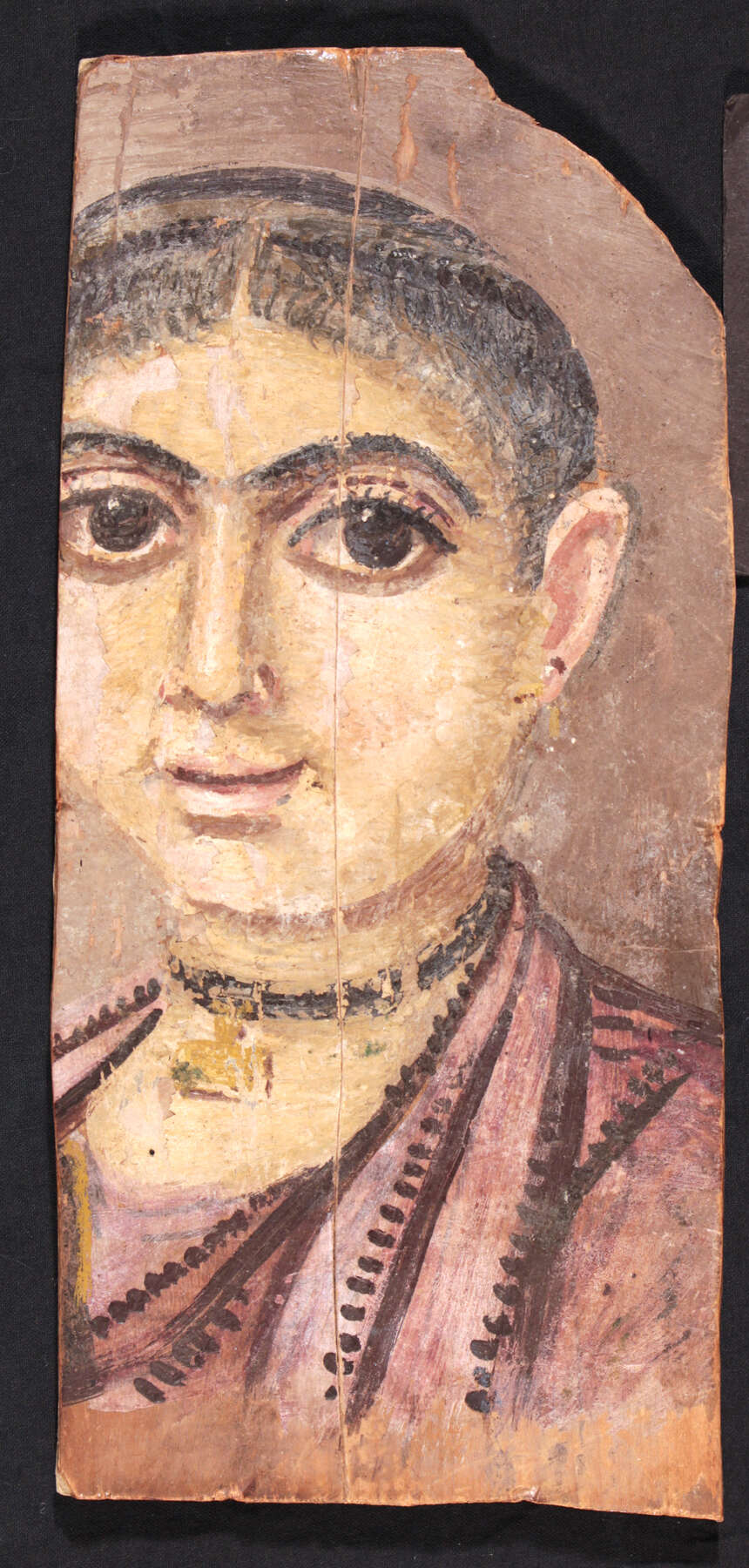 Figure 18.2a
Figure 18.2a Figure 18.2b
Figure 18.2bThe oxidized oil may attest to an intentionally modified encaustic, contamination, or a past restoration campaign. The relatively high concentrations of palmitic acid are likely due to the hydrolysis of wax esters and the subsequent formation of a fatty acid metal soap (i.e., lead palmitate). This soap was identified in the lighter-colored samples, which possess a greater amount of lead.
Egg Coating
Visual examination shows that the two encaustic portraits, AEIN 681 (fig. 18.3) and AEIN 684, have unpigmented, deteriorated surfaces. Both works entered the Ny Carlsberg Glyptotek from the Theodore Graf Collection in 1892, and they likely originate from er-Rubayat. Amino acid analysis by GC/MS revealed that both coatings matched egg protein (fig. 18.4); however, they differ in their visual appearance and response to , in their thickness, and in the method of application. The coating on AEIN 681 exhibits a bluish-yellow fluorescence, is very thin and glasslike, and has cracked into tiny “islands” with sharp edges. Although now only in scattered areas, the coating likely covered the entire portrait at one time. In contrast, AEIN 684’s coating shows a brighter bluish yellow fluorescence under UVF illumination, is thicker and more translucent, and has a yellow tone, presumably due to aging/deterioration. Numerous tiny, lightly curled fibers are observed embedded in the coating.
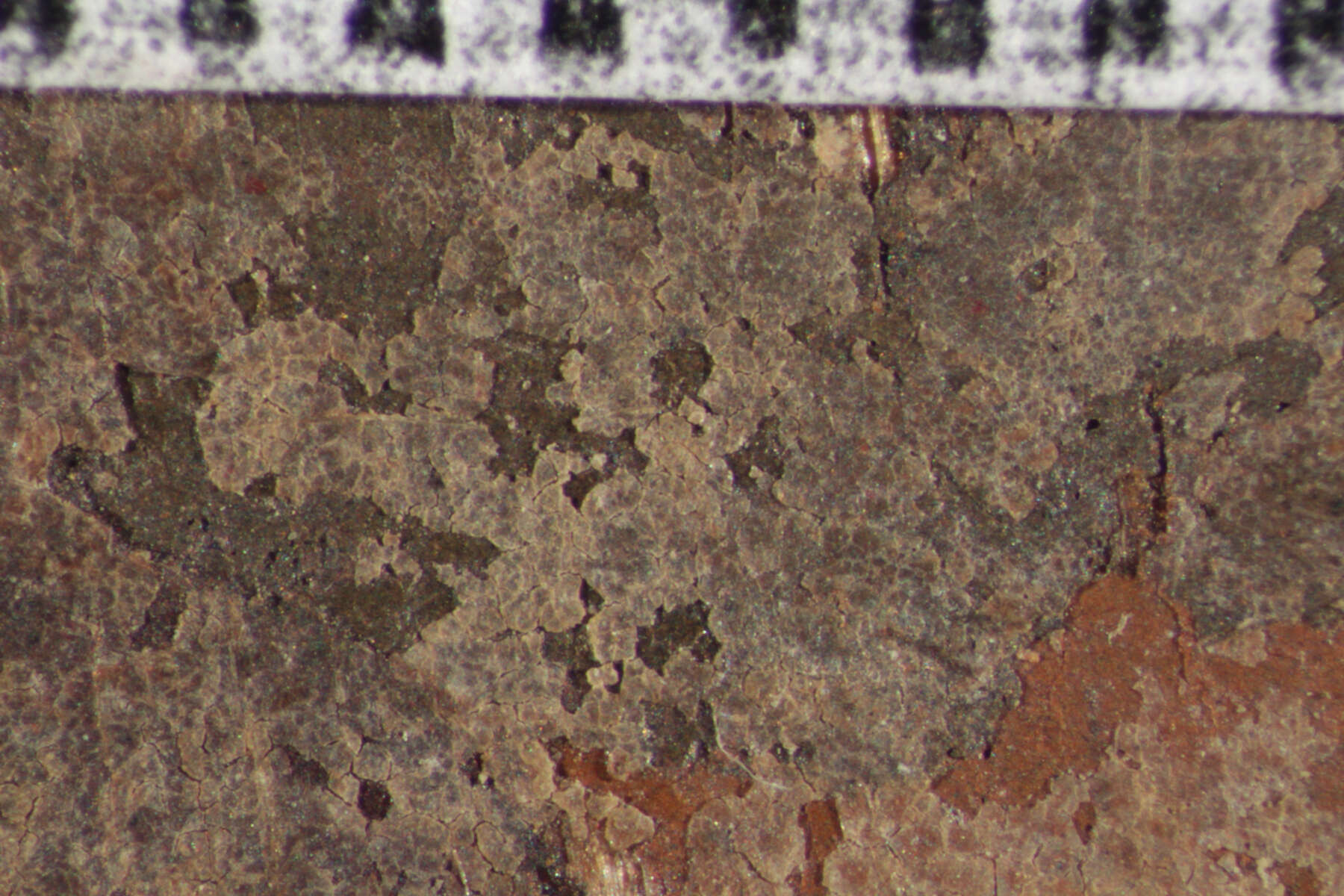 Figure 18.3
Figure 18.3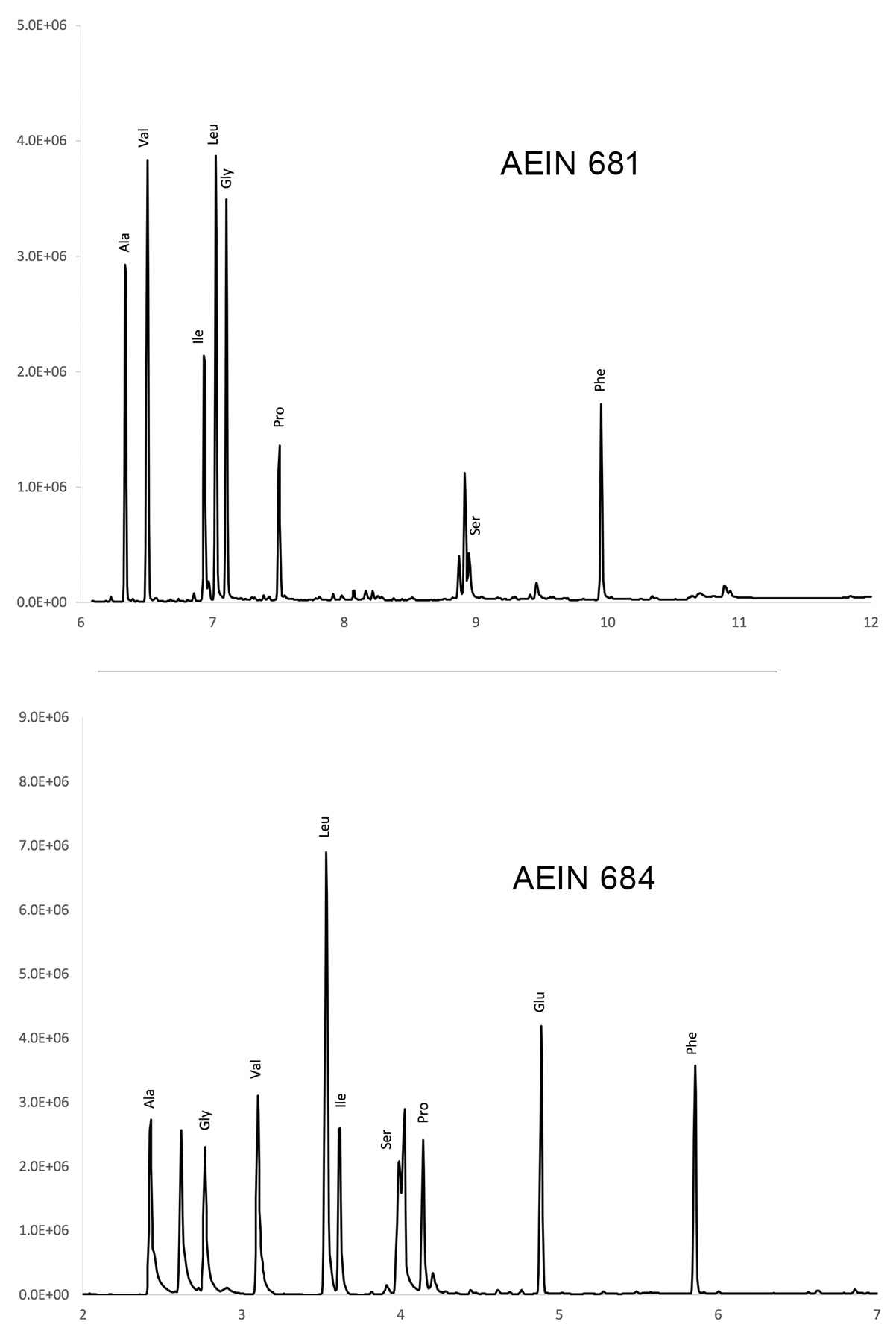 Figure 18.4
Figure 18.4Due to the locations of surface deposits and incrustations, these egg coatings are presumed to be original. Remains of resin from mummification, superficial layers of sand or dirt (burial material), and a lack of this coating within the more recent surface cracks support this hypothesis. Under UV light the egg coating on AEIN 684 (see fig. 18.5) reveals a distinct fluorescent border at the bottom of the portrait and a faint one at its top. The coating is not present where the mummy wrappings would have covered the ; therefore, we suggest that the coating was applied after attaching the portrait to the mummy, perhaps as a votive act. Further research is necessary to identify other portraits with similar coatings and to compare them with later egg coatings and varnishes applied to icons, medieval paintings, and sculptures.4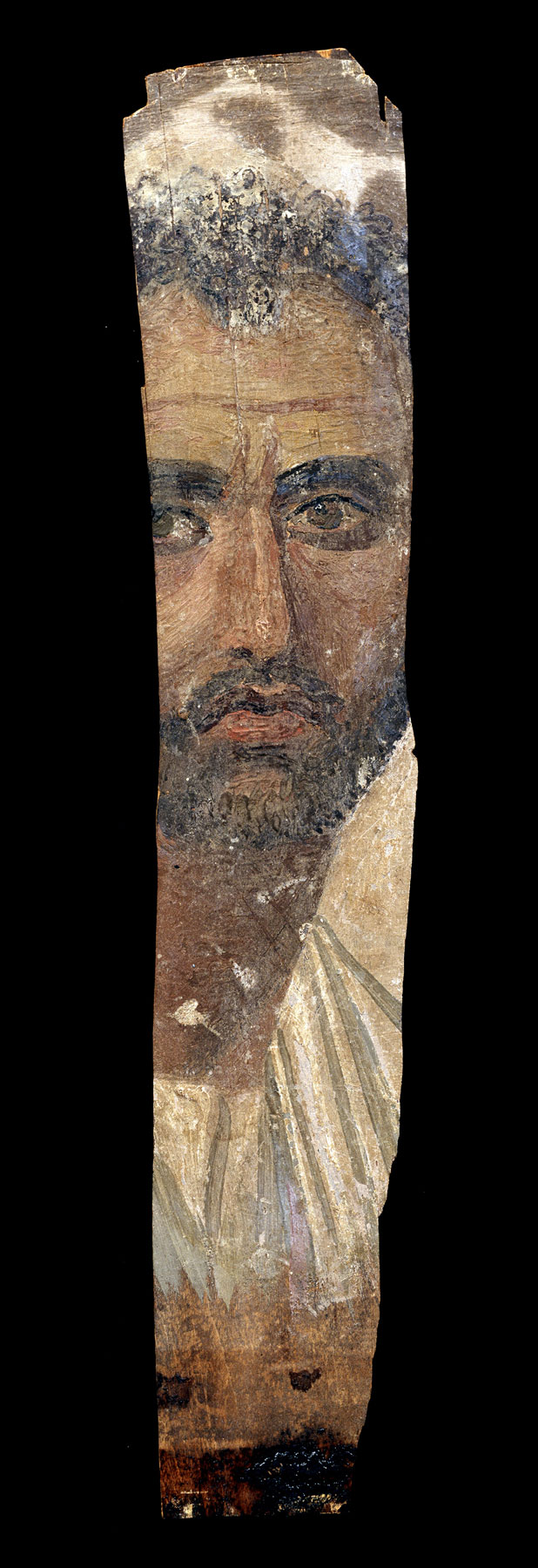 Figure 18.5a
Figure 18.5a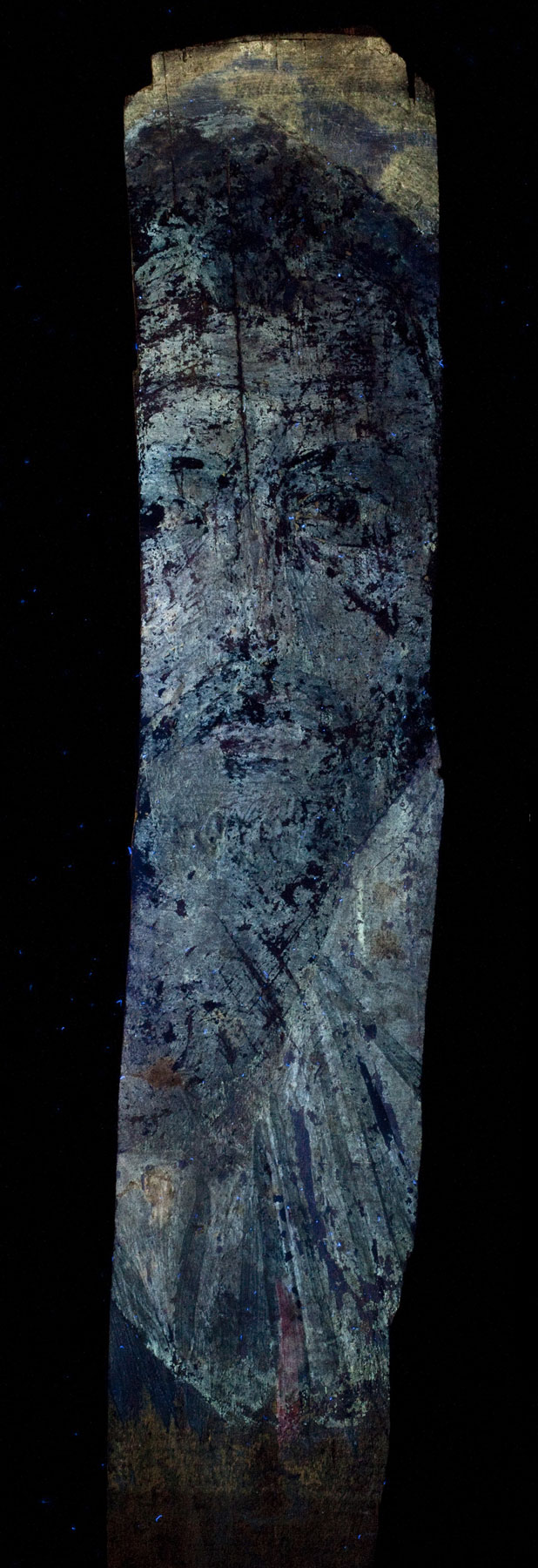 Figure 18.5b
Figure 18.5b
Acknowledgments
We thank the National Museum of Denmark (NM) and the Ny Carlsberg Glyptotek for their kind permission to examine and take samples from their mummy portraits. We also thank the staff at both museums; Michelle Taube (NM) and David Buti, Centre for Art Technological Studies, for the XRF examination; and the Carlsberg Foundation and the Getty Conservation Institute for their generous support.